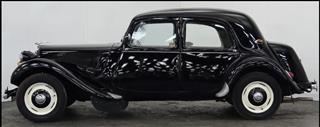Carburettor woes and repair on a Traction Avant
Early this year I decided to re build my original Solex 32PBIC carburettor and well, broke it….. I snapped off the soft emulsion tube top trying to remove the correction jet (apparently they are sometimes held with ‘locktite’ which I learned later and should have left it well alone )
The Solex 32PBIC Downdraught Carburettor was also used on the Porche 356, Some Simca Cars, a version was also used on the Hotchkiss jeep as well as other vehicles of a similar period, but original Solex made ones are no longer available to buy 'new'.
Having no other option, I bought a 'Copy' of the Solex Carburettor from TOC Club Stores and have ran the car with that fitted all summer, but it never felt right and constantly ran weak when Traction’s on the whole tend to run rich I was reliably informed.
It also was a problem starting the car on a couple of occasions as there was a lack of fuel at the Carburettor strainer which we thought was an airlock caused by vaporisation?
Now the Solex Carburettor is a simple 'Downdraught' design. Basically the vacuum caused by the engine sucks the fuel and air mixed by the carburettor down into the cylinders with few moving parts, only a float to control the level of petrol, a butterfly valve which opens and closes via the accelerator pedal to control the engine speed, a small accelerator 'pump' to add fuel when the accelerator is pressed hard and a simple 'choke' device to enrich the mixture for cold starting as shown in the diagram on the right.
The size of the jets dictates how much fuel is added to the air and as long as the correct jets are fitted and clean there should be few issues with it.
Now when I fitted a new petrol pump a couple of weeks ago I found that the Carburettor leaked petrol when pumped and primed by hand. Logically, if petrol can come out, then air can get in. So decided to investigate and discovered the Carburettor top was uneven and warped which is something referred to in some old Solex documentation I found online.
Using a flat surface I found that there was a gap of 0.20mm at the accelerator pump jet area reducing down to 0.10mm at the float end of the top section. Now the gasket used between the top and base is only 0.20mm thick and fairly stiff so was not going to fully take up that gap when the top is fitted and tightened, no matter how hard you try.
You can see the high spots in the centre image above and the not so good finish on the face of the top section so I decided to use the original Solex top that I had and lapped that smooth as it was a better quality casting using some old engineering skills.
To do it, I removed the needle valve, inlet strainer, then the 2 locating pins (grab the pins with a pair of pliers and pull and twist as they are simply an interference fit)
Once clear, I used a marble kitchen chopping board as a level base (a thick glass or smooth plastic one will also do as long as they are flat) and a sheet of 600 grit wet n dry. With minimal pressure I slowly lapped the surface clean and flat.
Once cleaned and flattened (around 10 minutes only was needed) the old top was fitted to the copy Carburettor with a new gasket, being careful NOT to over-tighten the 3 bolts potentially distorting the top again.
The Solex Carburettor has a 'Bi Starter' function, basically a choke cutting air and enriching the mixture which is s simple brass disc facing the polished carburettor body. If there is a problem with the disc you can 'lap' that as well if it’s scored to improve the face but as it is metal to metal without a gasket, use 2000 grit paper and a light oil as a lubricant to ensure a very fine finish.
Now the car starts better and the choke can be fully pushed in once running and it will idle without choke when cold (it didn’t before) although still needing a bit of choke for a short time when driving. Hopefully the 'air lock' issue is gone as well as it was probably fuel evaporating through the leaking gasket joint.
On a positive note on the copy Carburettor: The emulsion tube holder fitted to that is brass, not white metal aka an original Solex so is an improvement and should allow the correction jet to be changed if needs be in the future.
Now people have complained over the quality of the copy Carburettors in the past, but the French Army apparently used them and most of those available to buy now purportedly are ex French Army stock so don’t be put off buying one of those Solex copies, just be aware that they may need a bit of checking and improving to get running like an original one as indicated below.
The main complaint with the copy carburettors tends to be 'running to rich' indicated by sooty black spark plugs and Mark Harding from Devon Tractions feels that it's down to the level of fuel in the float chamber. If to high 'it seems to flood the little air mixer-tube in the centre of the venturi' and the solution is to increase the thickness/add another washer under the actual needle valve so it cuts off the fuel earlier, giving a lower level in the float chamber.
Last revision: 13th May 2019

